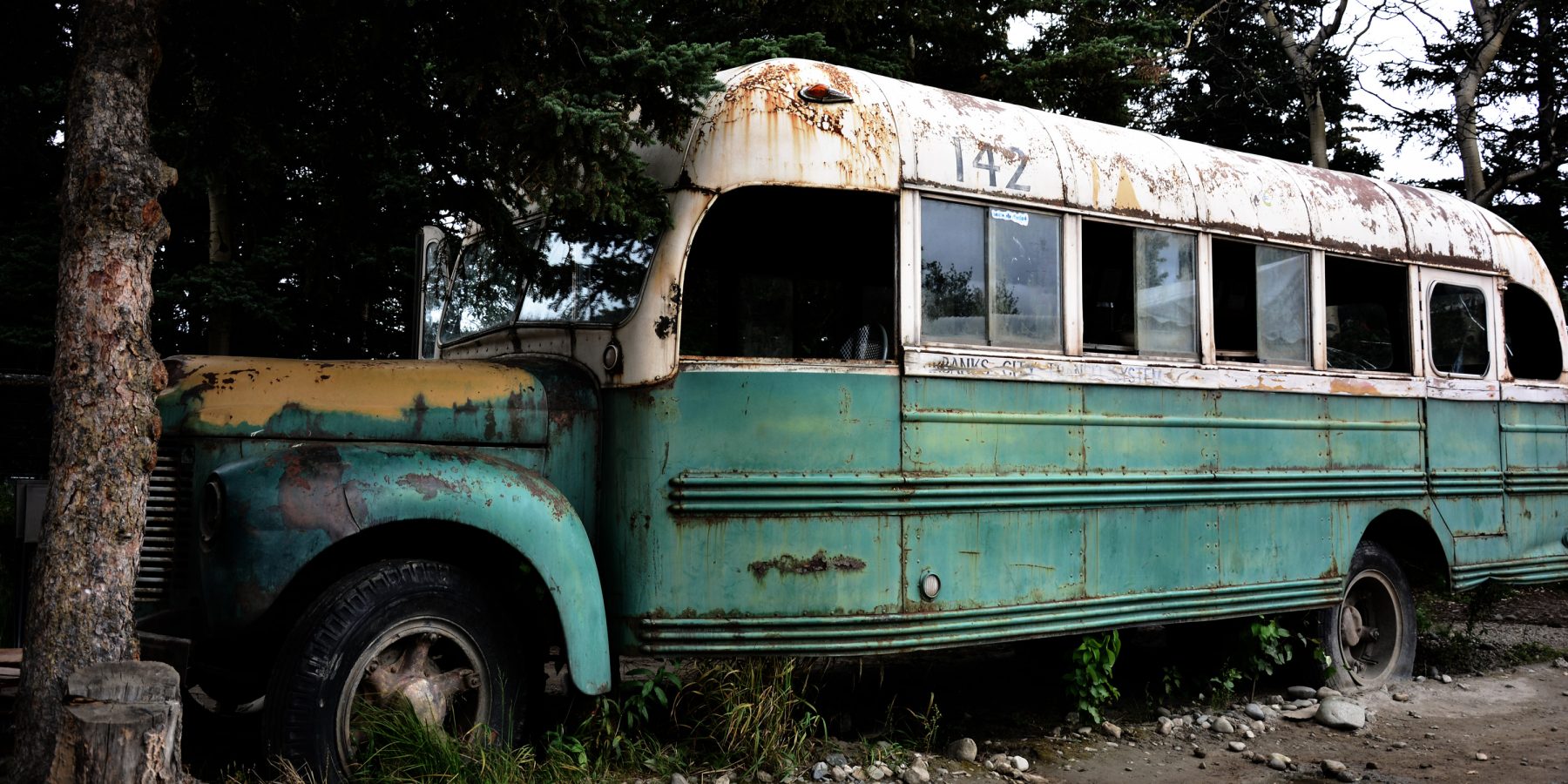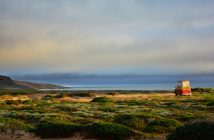In 1996, the journalist Jon Krakauer published a book called Into the Wild. It follows the life of a young man, Chris McCandless, who came to considerable fame by dying in the Alaskan wilderness near the town of Healy. Since then, Krakauer’s tale has been turned into a successful movie and both the book and the film have made Chris McCandless into something like an pop-culture icon for travelers. A reputation that McCandless himself would probably have hated. It also doesn’t do the ideals that this man lived and died for justice.
Healy, Alaska is a rugged small town, only a few miles north from Denali National Park, which surrounds Mount Denali – or Mount McKinley, as it was formerly known – the highest peak in North America. Healy is home of an excellent craft brewery, the 49th State Brewery. Just off the highway in Healy, they offer 12 delicious beers on tap, a large courtyard with benches and tables where locals and tourists from around the world eat, drink, and share their stories about the bears and moose they’ve seen and the adventures they’ve had in the Alaskan wild. In a corner of the courtyard, next to a live music stage, sits the wreck of an old city bus, the pale green paint coming off in many places. “Fairbanks 142” is painted on the side. Although the beer here is fabulous, this bus is the main reason many tourists stop here. The bus is a prop from the movie Into the Wild. It is a pretty accurate replica of the bus that Chris McCandless used as a home during the months he lived in the wilderness about 20 miles out of Healy. It is also a replica of the place where Chris McCandless died.
Into the Wild has become a part of Alaskan culture
McCandless’ story has found us again and again since we started to plan our trip to Alaska. Somebody even told us “Don’t become the next Into-the-Wild-Dude up there”, meaning we shouldn’t go unprepared and underestimate the wildness and remoteness of the northern country. A strange comparison, given we can hardly go anywhere not accessible by car. Asked what they know about Alaska, chances are half of your drinking buddies at the bar or the friends at your potluck dinner will mention Into the Wild. Certainly almost every Alaskan will have heard of it.

Essential Alaska reading
It was only when we planned to go to Alaska for the summer that I learned about the story at all. I had known Into the Wild was a movie based on real events about a guy who died in the wilderness. That it was based on a book, that this tragedy has played out in Alaska at all, that people care about this person, or rather the story that McCandless’ tale embodies, I had no idea. After hearing about it over and over again, and especially after realizing we would travel through Healy, the town closest to the “wild” place where he had died, I quickly decided I had to know more about this.
But what is the story of this Chris McCandless, and why does it matter to people? Interestingly enough, both questions are not easy to answer. First of all, because McCandless himself left little more than photographs, a few letters, and markings and notes in the books he had read. His story is known because Jon Krakauer, an investigative journalist and writer, decided to research it and write it down. Secondly, McCandless’ tale means very different things for different people, the conclusions they draw from it are even contrasting, depending on their background and prejudice.
Chris McCandless was born in a suburb of Washington, D.C. into an upper middle class family. He was a bright kid, excelling at most things he did, but also highly idealistic and individualistic. After graduating college, he decided that the legal career he had studied for was not what he wanted from life and he went to live on the road instead. He tramped around the United States and Mexico, working here and there for a while, trying to prove he did not require a “society” to rely on. Money and possessions were ballast in his book, keeping people from living a fulfilled and meaningful life.

Inside the bus replica at the 49th State Brewery in Healy. McCandless’ bus had a stove, a bed, and a few shelves as well.
After pinballing around the country for about two years, he decided that spending a summer alone in the Alaskan wilderness would be the ultimate challenge. A way to deliver the final proof that the scaffolds of society were not needed for survival, that one could live free from the chains of modern life that tie us down and keep us from being happy. He planned to stay in the wild for a few months and then return to the rest of the world. For the longest time, from April 1993 to about August of the same year, living in an abandoned city bus in the woods, not seeing a single soul, his adventure went well. Then, a few rookie mistakes, combined with some bad luck, changed his fate and led to his death in September. The actual cause of death is unclear even today, but it seems likely he died after poisoning himself through eating poisonous or rotten plants. This, combined with the fact that a river he crossed easily in spring had turned into a wild stream by the time he intended to cross back to civilization in late summer, seemed to have lead to his eventual death.
McCandless has become a symbol of wilderness stupidity and a role model at the same time
So, besides the fact that it is a tragic story, what is so interesting about Chris McCandless? For many Alaskans, McCandless is a symbol, a classic example of a stupid young adventurer, coming to the Last Frontier with a head full of fluffy dreams and little connection to reality. For them, he died because he was inexperienced and careless, because he didn’t know what he got himself into. The modern equivalent of a goldrusher, chasing dreams instead of shiny metal. They seem almost offended that he could treat their wilderness with such utter disrespect.
For travelers across the globe, however, McCandless is a hero, a role model for a life off the grid and outside the norm. The fact that these life choices eventually killed him only seem to emphasize the appeal. In a way, McCandless is a modern martyr. He died for his belief that a different way of life is possible, a “traveler messiah”, dying for all of us wanderers searching for a way to live our dream.

A sign at the sign forest in Watson Lake, showing how Chris McCandless , who nicknamed himself “Alex Supertramp”, continues to be a role model for travelers today.
In reality, it’s likely McCandless was none of the above. Yes, he made mistakes in the wilderness that eventually killed him. But he also managed to spend several months before that entirely on his own, staying alive and even healthy without the help of a single other person. Yes, he believed in a different life where our capitalistic society doesn’t have as strong a grip on our fate, and yes he tried to make the people around him see and understand his view of the world. But he was not a preacher, he did not try to change the world, rather realize this dream for himself. And most of all: Most of the tourists coming through Healy today, who take pictures with the bus and post them on social media, they share few of the values McCandless lived by.
Should we visit the actual “Magic Bus”?
Standing in front of the brewery, we met an Australian guy. “This is what I came to Alaska for,” he told us. He said the reason for visiting the state was to go on the Stampede Trail, the path leading to the actual bus that is still there, about 20 miles off the highway outside of Healy. He had arranged a tour with a local guide to take him to the bus, paying several hundred dollars. But due to the Teklanika river being too high, the same river that had stopped McCandless from returning from the wild, the trip was canceled. “But I found a guy in town”, he continued as we stepped into the bus in the brewery yard, “he runs a helicopter business and he’ll take me to the bus tomorrow.” I asked him how much he had to pay for the ride, he replied “It’ll be about a thousand bucks, I guess”. A trip to Alaska and a thousand dollars, just to see a bus in the woods, to see the place a young idealistic man decided to call home and where he perished trying to realize his dream. It doesn’t seem likely Chris McCandless, the man who gave away his savings and burned all the cash in his pocket, would have liked this way of honoring him.

The Alaskan wilderness: rivers, trees, and endlessness. Photo by Klim Bulygin
Since it became a legendary place, thousands of people have traveled the Stampede Trail to the bus, slept in the wreck, and left their mark. Graffiti lines the inside of the bus, we’ve been told. Some are by McCandless himself, but most are left there by his disciples, walking, driving, even flying into the wilderness to get to the “Magic Bus”, as McCandless had called it in a diary entry. Many who visit the bus get in over their heads, and have to be rescuced by the State Troopers. One tourist, according to the Lonely Planet, even died trying to reach the bus in 2010.
 We decided against visiting the bus, partly because of the difficulty of reaching it, partly because we felt it wouldn’t feel “right” to go to this place as tourists, somehow dishonoring it. So, what is it that rubs me the wrong way with how the story of Chris McCandless is treated by the traveler community? It has become a pop-culture icon, a caricature of a free life, appealing to millions. A shiny hipster Instagram version of what it was that – according to Krakauer – McCandless had tried to achieve. I feel it does not do justice to his ideals, ideals that I do not necessarily share in the extreme way that this kid lived them, but that are nontheless in a similar direction of how we are trying to live our lives: on the road, outside the lines of what many consider the normal patterns of our society, and determined to fulfill our dream.
We decided against visiting the bus, partly because of the difficulty of reaching it, partly because we felt it wouldn’t feel “right” to go to this place as tourists, somehow dishonoring it. So, what is it that rubs me the wrong way with how the story of Chris McCandless is treated by the traveler community? It has become a pop-culture icon, a caricature of a free life, appealing to millions. A shiny hipster Instagram version of what it was that – according to Krakauer – McCandless had tried to achieve. I feel it does not do justice to his ideals, ideals that I do not necessarily share in the extreme way that this kid lived them, but that are nontheless in a similar direction of how we are trying to live our lives: on the road, outside the lines of what many consider the normal patterns of our society, and determined to fulfill our dream.
“Happiness is only real when shared”
On the other hand, there is a sentence McCandless wrote on the backside of his journal: “Circumstance has no value. It is how one relates to a situation that has value. All true meaning resides in the personal relationship to a phenomenon, what it means to you.” Following this thought, there is no objective view on the world; things only become meaningful by interpreting them through one’s personal perspective. In this sense, either interpretation of the tale can be true. As long as it brings true happiness and enriches one’s life, there is nothing wrong with taking a helicopter ride to Fairbanks bus 142 – just as it’s fine not to do it.
“Happiness is only real when shared”, is another famous quote by McCandless, scribbled on the side of a page of Boris Pasternak’s Doctor Zhivago. If not necessarily happiness, McCandless shared his inspiration and ideals with generations of travelers following after him. They discover his story through their own subjective view of life, traveling this world, living their own version of Into the Wild.





1 Comment
I love learning new things!!!!!!! Fascinating! Thanks!